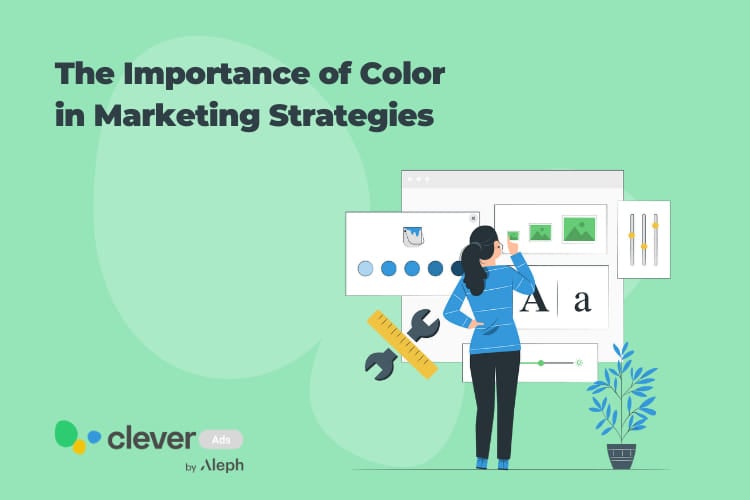Psychology of Colors & Marketing Strategies Lesson
Since the dawn of humankind, color has played an integral part in the way we understand the world around us. Differentiating between various colors and their shades has proven to be crucial in the survival of the human race as a whole. Because of their importance colors are deeply woven into our vision of the world around us. For example, hospitals typically use warm and gentle colors to invoke feelings of calm and serenity. On the other hand, we always associate urgency and danger with more intense colors. So color has to be part of your marketing strategies.
Psychologists started recognizing the importance of colors and ideas we associate with them a long time ago. Fortunately, marketing specialists caught on and began implementing the knowledge color psychology provides in order to come up with more effective marketing strategies. In this article, we’ll try to give you a glimpse into the world of the psychology of colors.
First Impressions
The first thing we notice about a product is its color. According to information compiled by DesignAdvisor, the average shopper takes around 90 seconds to reach the first judgment about a product and between 62% and 90% of this judgment is based on color alone. When it comes to brand recognition, color is responsible for 80% of it. It’s also interesting to note that if the appliance doesn’t come in their favorite color, almost two-thirds of shoppers will not buy it. See it is important for marketing strategies?
An interesting example of the power of color is the time Heinz ketchup’s marketing team decided to change the color of their product from red to green and this lead to $23 million increase in sales in just seven months.
Shoppers And Colors
When it comes to colors, both genders have interesting similarities in taste. For example, both men and women prefer green and navy blue in their products. Both sexes also dislike orange and brown, but men also dislike purple colored brands which, ironically, women find appealing. If you wish to sell your product online, call to action button must be red, green or orange. But remember: these colors won’t help unless they stand out from the general color scheme of the website. Another critical factor is the navigability of the website. All the fancy colors in this world won’t help if customers don’t find the overall layout of your website appealing.
While color preferences may vary across demographics, certain patterns emerge that warrant attention. Research indicates that both men and women gravitate towards hues like green and navy blue in product branding. However, nuances exist, with men displaying aversion towards purple, a color that paradoxically resonates with women. When crafting marketing materials, it’s crucial to consider these subtleties to ensure resonance with diverse audiences.
Choose Your Brand Colors Wisely
As we mentioned in the beginning, the human brain has learned to interpret different colors as symbols of certain emotions and messages – for example, red stands for life, excitement, and boldness. It’s interesting to note that this color increases the heart rate and conveys a sense of urgency, which is why it’s commonly used for clearance sales. Contrary to that, blue symbolizes productivity, tranquility, and trust, and is mostly used by banks and businesses to communicate stability.
Recent Insights and Research
Recent studies in color psychology shed new light on the intricate relationship between color and consumer behavior. For instance, a study conducted by Marketsplash revealed that color plays a pivotal role in shaping brand perception, with up to 90% of consumers forming initial judgments based on color alone. Moreover, 80% of brand recognition stems from color, underscoring its undeniable influence in the competitive landscape.
Illustrating Success with Case Studies
In the ever-evolving marketing landscape, staying abreast of successful case studies is imperative.
A prime example of a brand that has invested significantly in color research is Coca-Cola. This brand is known for its meticulous approach to creating and maintaining its brand image, and the distinctive red color of its packaging and logo is a key element of that identity.
Coca-Cola has conducted extensive studies on the emotional and psychological impact of the color red on consumers. The company has invested millions in market research, concept testing and data analysis to understand how the color red influences brand perception, product appeal and purchasing decisions.
These research efforts focus not only on the product color itself, but also on its application in advertising, packaging and overall visual identity. Coca-Cola continues to refine and adapt its color strategy to remain relevant and appealing in a highly competitive global marketplace.
Integrating Visual Content for Impact
Incorporating visual elements enhances the effectiveness of communication, particularly when delving into the realm of color psychology. Infographics, videos, and interactive graphics can elucidate complex concepts and captivate audiences, facilitating deeper engagement and comprehension.
Adapting to Online Marketing Trends
In today’s digital age, the significance of color extends beyond physical products to encompass online branding and user experience. Web designers must navigate considerations such as color contrast, accessibility, and mobile responsiveness to optimize the impact of their color choices in digital marketing endeavors. Additionally, incorporating insights from search engine marketing (SEM) and search engine optimization (SEO) can further enhance online visibility and brand recognition.
Navigating Cultural Sensitivities
As businesses expand globally, understanding cultural nuances in color perception becomes paramount. Colors that evoke positive associations in one culture may carry entirely different connotations elsewhere. By embracing cultural diversity and tailoring color strategies accordingly, brands can foster deeper connections with diverse audiences and avoid unintended missteps.
Conclusion
In conclusion, the psychology of colors represents a potent tool in the marketer’s arsenal, capable of eliciting emotions, influencing perceptions, and driving consumer actions. By staying abreast of emerging research, leveraging compelling case studies, and embracing visual storytelling, marketers can harness the power of color to forge meaningful connections and propel their brands to new heights in the dynamic landscape of modern marketing.
All in all, the color palette is one of the most important aspects of product branding, so make sure you decide what kind of message do you want to convey to your customers before using any particular color. And, if your branding and color marketing strategies are clear… How about to learn a little about Google Ads for eCommerce? Have you familiarized yourself with the PMAX campaigns from Google and Microsoft? They’re quite noteworthy and not to be overlooked!




